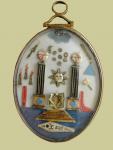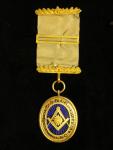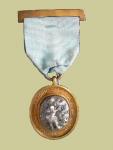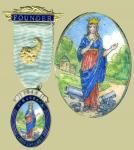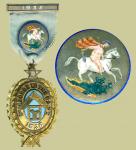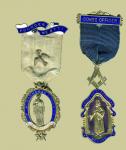
wm5806
Past Contributor-
Posts
230 -
Joined
Content Type
Profiles
Forums
Blogs
Gallery
Events
Store
Everything posted by wm5806
-
There's quite a detailed study been written by JT Thorp, entitled "French Prisoners' Lodges" from the Leicester Lodge of Research in 1935. The first edition was, I think, only a pamphlet produced around 1900, but his research continued and expanded, resulting in quite a hefty volume and denoted the 2nd edition. Worth looking out for on some of the secondhand book search engines and about USD 100-150. Kindest regards WM5806
-
Very uncommon, I would say and very highly sought after. I don't have one myself, but if I saw one for sale, I would probably have to pay in the region of 200GBP (350-400USD) to obtain it.
-
I know very little about Italian political history, and even less about this Lodge's history. However, there are few references to it on the WWW: Loggia Italia No. 2687 E.C. was consecrated on 17 March 1898 in London (at the Cecil Hotel, the Strand). Sometime after its consecration, the date is not recorded, Loggia Italia was presented with a sword belonging to Giuseppe Garibaldi, Past Grand Master -1864- of the Grand Orient of Italy, used by him at ceremonial meetings. This sword is now lodged with the Library and Museum at Grand Lodge and is displayed at special occasions in front of the reigning Master at the top table. The Lodge works an Italian translation of the Emulation Ritual. (from http://users.senet.com.au/~frankis/ldv238/italianlodges.htm). Perhaps the Lodge was set up by Italian political exiles, not unlike the Huguenots who settled in London a century or so earlier? If that was the case, then they may have only selectively adopted parts of their country's emblems for their own use? Is there an Italian expert out there? WM5806
-
Mike Pictured below is the presentation jewel for the Consecrating Master. By virtue of that, it must have been made around or just after 1897. You can see that there is no crown on the Italian flag: [attachmentid=26829] Perhaps some one more erudite than I might be able to inform us why? WM5806
-
Yes, there was a trend to glass-in the jewels around that time. Not sure why, whether it was to keep the dust out (lot of powder from the wigs worn then, or do I have my history muddled?), or because in some cases they were quite delicate. An example of the latter are the French Prisoner of War jewels made here, especially in Devon because of them being quartered around Princetown, so that their makers could earn money for food. They made very intricate collages of masonic symbols out of scraps of material: bone, ivory, hair, wire, in fact anything! They were sold to local Masons and are truly magnificent to see, especially when you remember that they are nearly 200 years old now. I will enclose a picture of one in this post, but make no apologies for not reducing it's size as you need to see the detail. WM5806 [attachmentid=26827]
-
I'm lucky enough to have held two different examples in my hand, but the picture came from a Web site on my cyber-travels. Quite possibly from the GL of BC and Yukon, but may have been from elsewhere. Although not strictly Masonic, it is quite a desirable jewel for most jewel collectors purely because of its scarcity. Very interesting story behind it - check out the link in post #3 WM5806
-
I presume you mean on the Italian flag, Mike? Good point - not sure about that - the jewel illustrated is for their 66th Worshipful Master, for the years 1964-65, which is just about legible on the pic. Not sure if they modified the flag for the jewel after the war.... I shall try to find an example of a pre-war jewel from this Lodge. WM5806
-
And another... This time for the Burlington Lodge (No.96), constituted on 2nd December 1756 at the Rising Sun, Air Street, Piccadilly, as No. 217 but not named until 1776. The Lodge celebrated its centenary 10 months too early, on 12th February 1856, according to Lane's 'Centenary Jewels and Warrants'. According to a recent yearbook (2000), the Lodge is still extant and meets elsewhere, but still still in London. WM5806 [attachmentid=26818]
-
Wish I could afford this one! It's up for auction in a week's time. A George IV gold masonic Past Masters jewel, of oval form with motifs over a blue enamelled background. Presented to Brother George Haslewood P.M. by the Brethren of British Lodge No. 8, 1828 Estimate ?500-700 [attachmentid=26757]
-
The United Grand Lodge of England proposed a regulation design for Centenary jewels in the 1860s. Hitherto, Lodges had been allowed to design and, if approved, wear their own centenary jewels. The picture on the left is of the 'pre-regulation' centenary jewel for St John the Baptist Lodge (no. 39), founded in 1732 - and still meeting in Exeter today - and that on the right is the 'new' design to be worn by all Lodges apart from from those previously granted permission to wear their own design jewels. Hopefully, if enough interest, more of the pre-regulation designs to follow. WM5806 [attachmentid=26695] [attachmentid=26696]
-
No replies, so I thought I ought to let you in on the answer! The jewel is from the Gormogon Society, a quasi-Masonic breakaway group in the 1700s. There's a very good article on them hosted on the Grand Lodge of British Columbia and Yukon's website which explains it in greater depth. A very rare medal, it is thought that there are no more than about five or six exist in the world. Hope you enjoyed it! WM5806
-
Lodge La France (no. 2060), formed in 1884 and meeting in London - Member's jewel. Ritual worked in French. [attachmentid=26372]
-
Nice idea, Mike, However, I have tried similar when translating from German via Google's free service and you have to watch out for things like "the free brick-layers" Regards WM5806
-
Another 'dual-nationality' lodge: the Anglo American Lodge (no. 2191), formed in 1887, 'with the view to drawing closer together the bonds of Masonic Union existing between the two countries' (Mendoza H., Serendipity, 1995). [attachmentid=26277]
-
I did buy them from a seller in the US a few years ago
-
Not only that, but there's also an allusion to the Stars and Stripes behind the eagle. Any ideas, anyone?
-
Hi Mike Hot sure if it's KT or what it might be. Although I am not in that degree, I can recognise the columns from a Craft (Blue) Lodge and the monogram on the cube in the centre of the floor is used in the Red Cross of Constantine degree. It may be the 'normal' lay out for a German Lodge? Perhaps another viewer can help here? Regards WM5806
-
Some jewels from Columbia Lodge (no. 4682) which meets in Acassuso, Buenos Aires, Argentine Republic, but received its warrant from the United Grand Lodge of England in 1924. It must have been quite a wealthy Lodge as the Past Master's and Treasurer's jewels are made of 9ct gold. [attachmentid=26256][attachmentid=26257][attachmentid=26258]
-
Here's a Past Master's jewel from Hortus Lodge (no. 2469), a Lodge formed for Covent Garden traders. Covent Garden is the site of an ancient fruit and vegetable street market in London, not far from the headquarters of the United Grand Lodge of England at Great Queen Street. [attachmentid=26246] Quadragesimus octavus - forty eighth (Master of the Lodge) Hortula Boni Omnes - Horticulturalists are all good? My Latin is appaling, sorry WM5806
-
The United Grand Lodge of England - the governing body of Freemasonry in England and Wales. Scotland and Ireland have their own respective Grand lodges. WM5806
-
Hi Tom Price would vary with age, intricacy, metal (silver-gilt or gold), etc. My best guess of the market value of these would be (left to right) ?100-130, ?90-120, ?70-80. The carbon Lodge is particularly intricate with a beautiful enamel and quite old (1902), the Telephone Lodge a little newer (1908) and the Electra Lodge newer still (1929). WM5806
-
Many Lodges are/were formed by existing Brethren who had a common interest, whether that be a hobby, school, university, regiment or, in this case, a common occupation. The jewels below are from Carbon Lodge (no. 2910) for those working at the London Coal Exchange (note the mining trolley on top of the bar and a Davie lamp at the bottom), Telephone Lodge (no.3301) which I think was for those in the old GPO, and finally in this post, Electra Lodge (no.5124) formed by those in the electricity industry. Has anyone got any more? WM5806 [attachmentid=26089][attachmentid=26090][attachmentid=26091]
-
St Barbara Although nicely detailed, this enamel isn't in the same league as that of say the St Michael ribbon emblem (post no. 3), which dated from 1937, only 7 years before this one. It may have been due to the exigencies of wartime Britain, I believe that the enameller's finest work is (usually) from before the 1939-45 war and cite these example in support of that. Perhaps of more interest to viewers from other boards on this site, St Barbara became the patron of artillery and mining. In the Spanish language, the word "santabarbara" means the magazine of a ship or fortress. It was customary to have the statue of Saint Barbara at the magazine to protect the ship or fortress from suddenly exploding. Incidentally, the Order of Saint Barbara is a military honor society of the US for both the US Army and the US Marine Corps field artillery. (Source: Wikipedia) [attachmentid=26031]
-
St George - again! A 1935 Past Master's jewel from the Lodge of St George in the East (No. 1526), meeting in Bengal. [attachmentid=26025]
-
St Barnabas From two different Lodges named after St Barnabas, No. 3771 from London, and No.5050 from Birmingham (Warks), in 1916 and 1928, respectively. A recent yearbook shows two other Lodges with St Barnabas connections, one in Buckinghamshire, the other in West Kent. [attachmentid=26021]


